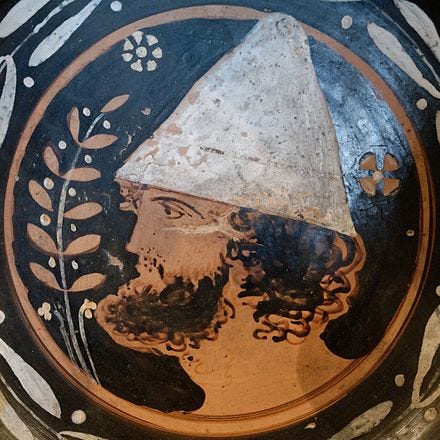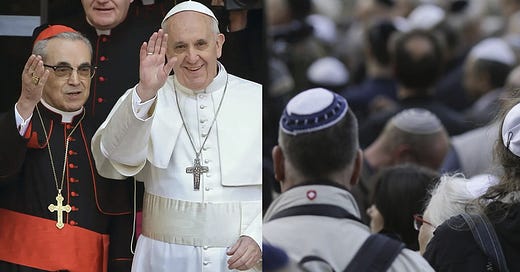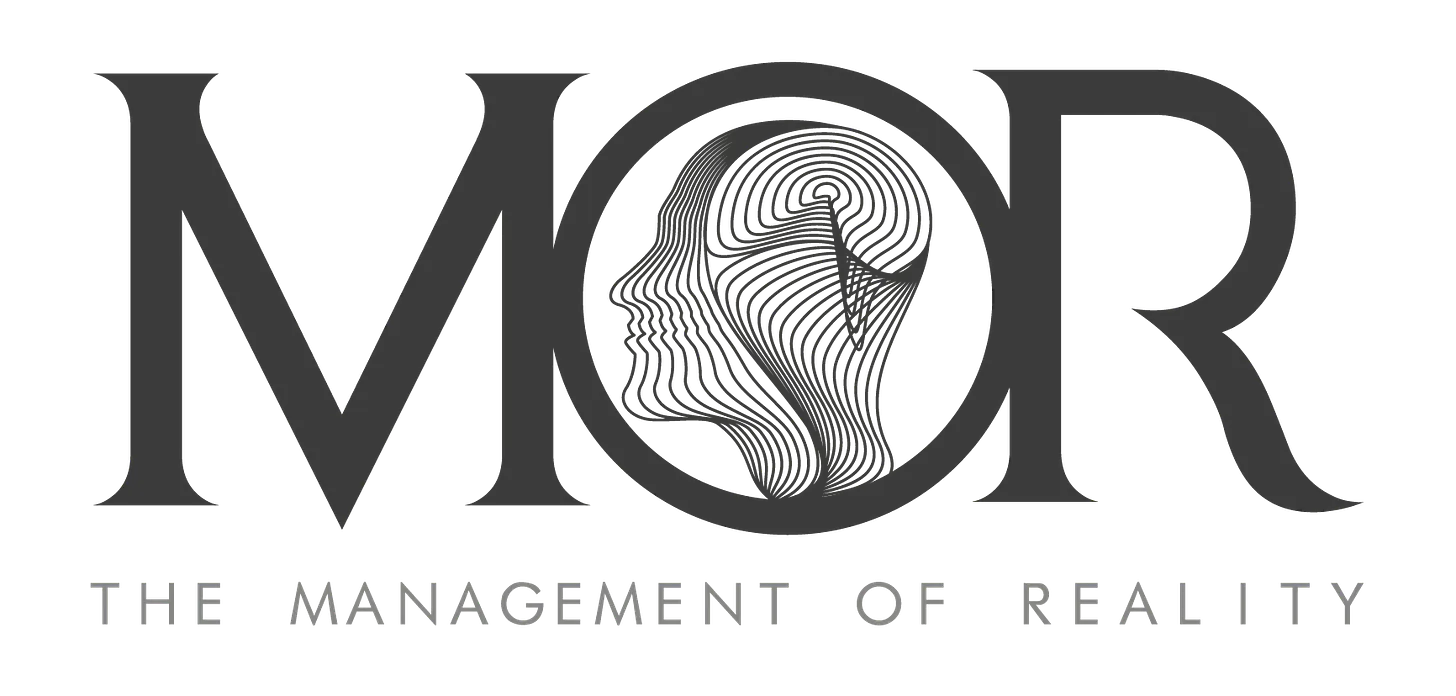The Church (and Western) paradox [SEMITISM vs. ANTISEMITISM Part 3]
An MOR series: SEMITISM vs. ANTISEMITISM: The structure of our history
PARADOX. The culturally Greco-Roman bosses who led the Church straight into totalitarianism (the Inquisition) declared holy 1) the story of an Israelite slave revolt (Exodus) that begat pro-worker laws; and 2) the love teachings of a Jewish hippie carpenter. How and why did oppressive Greco-Roman aristocrats adopt the subversive literature of lower-class Jewish revolutionaries?
If you didn’t read Part 2 yet, you may do so here:
Is the Roman pontiff wearing a Jewish kippah?
I love it when a big, system-level question can be meandered to by way of some colorful detail that is rich in anthropological insight. Allow me to approach our paradox obliquely, then, by drawing your attention first to this detail: the skullcap on the Pope’s head (see photo, above).
That skullcap looks to me very much like the kippah or yarmulke traditionally worn by Jews. Is that what it is? I’ve noticed some definite resistance to this idea on the part of various authorities. I have not been impressed, however, by their arguments and sources.
In The Crucified Rabbi: Judaism and the Origins of Catholic Christianity, for example, the Catholic apologist Taylor Marshall writes as follows:
“… [O]ne of the most common questions that Jews have concerning the Catholic Church is: ‘Why does your Pope wear a yarmulke? To be accurate, the Pope does not actually wear a yarmulke but a zucchetto, which is Italian for ‘little gourd,’ as in the vegetable we call zucchini … [because] it somewhat resembles half of a small pumpkin …”1
Discovering that the bishop’s skullcap has accrued an Italian nickname contributes absolutely nothing to refute the hypothesis that the bishops adopted the skullcap from Jewish practice, but that seems to go right over Marshall’s head.
It likewise goes over Wikipedia’s head (consulted 6/9/2024), for Wikipedia cites Marshall’s passage in order to ‘support’ the claim that “the zucchetto is distinct from … the skullcap style of kippah and yarmulke.”
Wikipedia also advances the undocumented but apparently mainstream claim that the zucchetto is derived from the Greek pilos. I find this idea striking because the zucchetto in fact bears zero resemblance to the Greek pilos (see for yourself below); by contrast, as Wikipedia concedes, the zucchetto “is almost identical to the Jewish kippah or yarmulke.”

Of course, the zucchetto cannot be a kippah if it appeared first. So, if you were really hell-bent on denying a Jewish origin for the Catholic skullcap you might even be tempted to say, as Wikipedia does, that “the zucchetto … predates the skullcap style of kippah and yarmulke.” That’s a remarkable claim, so I consulted Wikipedia’s footnote, which contains this:
Kilgour, Ruth Edwards (1958). A Pageant of Hats Ancient and Modern. New York: R. M. McBride Company.
No page number…
Well, modern search technology can help with that. I found an electronic version of Kilgour’s erudite book on hats and searched the terms kippah, zucchetto, yarmulke, and skullcap. The first three terms are nowhere mentioned in the book. But skullcap does appear in a brief reference to Jews and popes in the short section: ‘Italy: skullcap or cap of Enoch.’ Kilgour writes (pp.252-253):
“[The skullcap] was worn in very ancient times by the elders or teachers of the Jewish tribes … For this reason we sometimes find the headpiece referred to in ancient archives as the ‘cap of Enoch.’ Mentioned in the Bible, Enoch was one of the patriarchs of the early Jewish people, and presumably wore one of these little caps. … To the present day, the rabbi in the synagogue wears the skullcap, the same as the elders before him, marking him as a teacher. The cap has always been traditionally connected with religious figures so it is no surprise to find that the Pope, upon occasion, also wearing a skullcap.”
Just… amazing: Wikipedia’s source suggests precisely the opposite of what Wikipedia claims. (Always check footnotes, you never know when someone will try to pretend with a wet footnote that they have documentation.)
Perhaps if the Jewish kippah signified in Judaism something entirely different I could abide more tolerantly these desperate efforts to allege a separate line of cultural transmission for the Catholic skullcap. But, as Taylor Marshall concedes, “the idea is the same”: in both religions the skullcap “designates that a man is a servant of the Most High, ever standing in the presence of God.”2
Hm.
I am provoked to ask the following question. Given that the Church itself does not assert cladistic independence from Judaism but, to the contrary, claims to emerge phylogenetically from it; and given that, in the ‘parent’ religion the skullcap is physically almost identical and also means the same thing, shouldn’t the first hypothesis be—until truly impressive evidence is marshalled to the contrary—that the bishops were imitating the Jewish kippah?
Or put it this way: Is it really so crazy to suggest that the bishops wanted to look like rabbis?
Consider the context. The Catholic bishops, as everybody knows, cherish a set of teachings attributed to a very, very famous rabbi: Yeshua ha Nosri or Jesus of Nazareth. And the Church has proudly claimed to be the most Jewish religion. For according to the Church fathers and their doctrine of supersession, the only legitimate evolution of Judaism is their interpretation of Yeshua, which they claim is divinely ordained to replace the ‘parent’ branch of Judaism, now rendered obsolete. To this day, the Church calls herself—officially—‘The New Israel.’
I know what you are thinking, because the question is obvious: If the Church so proudly asserts her supreme Jewishness, indeed her unique legitimacy—to the detriment of Jews!—as the proper continuation of Judaism, then why did anyone go looking for the ancestor of the Catholic skullcap in the Greek pilos?
Well, perhaps because the Church isn’t any less Greco-Roman than she is Jewish, nor, on that score, any less proud.
The ideas of the early Church were attractive especially to Greek-speaking gentiles in the Eastern Mediterranean; soon after, as upper-class Roman citizens began to dominate the bishop class, and as the Church borrowed Roman forms for its own organization, she developed also a Roman identity (see Part 5). Greek and Roman identities mesh well because Roman culture is in many ways an evolution of Greek culture.
The Church’s Greco-Roman identity became hypertrophied when Emperor Constantine adopted the Church as official religion in the fourth century CE, thereafter fusing Church and Empire into a single, complex, Roman religious/political creature. It became entirely traditional to celebrate Catholicism as Roman, and Latin became the Church’s sacred language.
So the Church is both Greco-Roman and Jewish.
This hybrid identity is explicitly and loudly claimed by the Church in her long official name: ‘The Holy Catholic Apostolic Roman Church.’ ‘I am Apostolic,’ she says, meaning ‘from the friends of Jesus, the apostles’—all Jews—and ‘I am Roman.’
And that’s the Church paradox.
For the Jewish tradition is semitic; the Greco-Roman, antisemitic.
semitism and antisemitism
These lowercase terms, semitism and antisemitism, with the technical definitions I have given them, refer us to ideologies (as explained in Part 1 and Part 2). This is what the terms mean:
semitism → A social force launched by linguistic Semites 4,300 years ago in ancient southern Mesopotamia (Babylonia) with the revolution of Sargon of Akkad. This force seeks to protect everyone from oppression and trends in the direction of abolitionism, constitutionalism, and, finally, democracy. The Jews—a Mesopotamian people tracing their origin as a legal and religious community to the story of a slave revolt led by Moses (Book of Exodus)—are the surviving representatives of ancient Mesopotamian semitism.
antisemitism → A social force that has always opposed semitism and which seeks to oppress everyone, trending always in the direction of slavery, absolutism, and, finally, totalitarianism. In ancient Western Asia (which includes Europe) the most important antisemites were the Assyrians and later the Greeks and the Romans. In the modern world, the most important antisemites, drawing inspiration from the ancient Greco-Romans, have been the eugenicists and the German Nazis, and drawing inspiration from the Qur’an, the jihadi Muslims.
You can see clearly, with these definitions, that for an institution to be simultaneously semitic and antisemitic makes for a perfect paradox. Which of course leads us straight into the question: How can any such chimeric Franken-Church ever have emerged in our history?
We ought to be very interested in this question.
Two great eras
This question is sharpened when you realize, reaching back, that there was a time before the paradox, a time when semitism and antisemitism existed in a logical—rather than paradoxical—relationship to each other.
The dramatic shift from logic to paradox cuts all of our civilized historical experience—neatly and satisfyingly—into two gigantic eras, each roughly two millennia long.
The first great era begins with the revolution led by Sargon of Akkad 2,300 years before Jesus in southern Mesopotamia (‘Babylonia’). The second, after a transition period following the Greco-Macedonian destruction of the Persian Empire, begins with the founding of the Catholic Church in the first century CE.
This model is not so hard for Westerners to process and adopt. It is perhaps true that I am reaching further back and farther East than most of us are used to (from the point of view of our traditionally ‘Western’ identity) because I believe the Mediterranean and then Europe should be analytically integrated with Western Asia into one very large yet coherent system in which semitism struggles with antisemitism. But in another sense my model is an easy fit, as I fully concur with Western calendrical cosmology that our civilized experience should be divided into the time before Jesus and the time after Jesus.
The arrival of Jesus marks the transition from the logical to the paradoxical.

In the Era of Logic, before Jesus, back in our deepest Mesopotamian antiquity, the struggle between semitism and antisemitism was crisp (see Part 1 and Part 2). A good metaphor here is a pitched or set-piece battle, anticipated and committed to by both antagonists, each occupying one side of the field, each with its own colors and banners, and each hailing from separate and distinct home territories.
Such combatants are easily distinguished.
Of course, this ain’t just a metaphor. In the period that precedes Christianity, semitism controlled its own home territory of Babylonia, extended later to cover all of Western Asia, while antisemitism had its homeland to the West. And semites and antisemites indeed met on the field of battle—in gigantic confrontations. First, Babylonians vs. Assyrians, and then Persians vs. Greeks. The Greco-Persian wars (three in all, for I include Alexander’s conquest) were veritable world wars between two entire civilizations, one semitic, the other antisemitic, each in its own continent (see Part 1 and Part 2).

But in the Era of Paradox, the one we’re still in, which begins after Jesus, semitism and antisemitism have been paradoxically intertwined in an intimate embrace that makes their struggle messy and convoluted—and much harder to think about.
This messy struggle became wholly internal to Western civilization, for in this Era of Paradox the two opposed forces occupy the same geographic and cultural space and moreover raise the same institutional banner! More specifically, this paradox pits the Church’s Greco-Roman political structure against the Jewish values promulgated in the Church’s officially cherished holy books.
Schematically, we may represent that as follows:
By definition, a paradox does violence to logic. But paradoxes are not always noisily obvious things, for ‘obviousness,’ as every anthropologist knows, is not really a property of logic but of culture. Entirely made-up and/or nonsensical and/or contradictory things will seem perfectly obvious and natural to those socialized into accepting them.
We are used to the Church paradox—which goes mostly unnoticed—because it is fully Western.
The Church paradox is a Western paradox
The Church literally created our present civilization and inherited her paradox to us, because she managed to survive the fall of the Roman Empire to become, in the European Middle Ages, the dominant institution by far.

The Medieval Church crowned and also excommunicated the Germanic Holy Roman emperors, as well as sundry other European kings and queens whose disputes she helped resolve and whose confessed sins she carefully listened to and absolved.
In every European country, the Church was the biggest landowner, with huge agricultural estates. But she was no urban slouch. Indeed, one out of every ten people might be on the Church’s payroll in some European cities.
In every Christian kingdom and principality a system of ecclesiastical courts existed entirely beyond the control of king or prince, often extending their jurisdiction to many matters ‘civil’ rather than ‘religious.’
The Church also had its own State, several international armies of holy knights (by need and opportunity loaned to various kings), and a police force.

And last, but hardly least, a gigantic population of priests in every European country ministered to the faithful, high and low, taught them loyalty to the Church, and gave them what such times and places considered an ‘education.’ Everywhere you went the people with smarts—the scholars, the intellectuals, the thinkers—were all priests. The very sophisticated ones were indispensable advisors, of course, to kings.
Inevitably, then, the Catholic Church drenched and draped the paradox in her bosom over every corner of Western religious, cultural, and political life. And we are still living this paradox.
You too.
I know that many modern Westerners are walking about feeling very confident and satisfied in their presumed emancipation from the Catholic Church. But they are wrong.
Certain aspects of culture are very hard to change, because they are subtle. We can stop going to Catholic Mass, for example, but that hardly means the subtle aspects of Church cosmology that have drenched the West for centuries will quickly disappear, because they are difficult for us to notice. Identity and values, once internalized, are naturalized, and people effortlessly transmit them to their children, who will pass them on again, and so forth. They don’t even notice it, because naturalized aspects of culture are very difficult for those who own them to perceive. “Fish are the last to discover water,” goes an old saying. Just so.
Think only of modern environmentalism, a clearly Christian movement. Many environmentalists borrow from Eastern and native religions, and they hardly self-identify as Christians, but they have effortlessly recycled the concepts of ‘original sin’ and ‘redemption through sacrifice,’ merely dressing them up in new vestments.
Centuries of Catholic education and Sunday instruction led Westerners to internalize the Church paradox until it became culture, stable now without the Church’s constant micro-management and husbanding, transmitted from parent to offspring without any self-consciousness. Hence, by dint of being Westerners, whether or not we call ourselves officially ‘Catholic,’ we are living the Church paradox still.
And it makes us… schizoid.
The Church—and therefore the West—is schizoid
For the last two millennia, whatever happens in Western life in any given moment depends on which half of the Church paradox—semitism or antisemitism—has gained control of Western institutions.
The useful metaphor here is the intra-psychic struggle of an individual man with his own demons: two opposing forces—both claiming to be his allies—exist within him and compete for control of his prefrontal cortex.
Such combatants are not easily distinguished.
Once again this ain’t just a metaphor. Centuries of Church dominance caused the individual Western psyche to become simultaneously Jewish and Greco-Roman: semitic and antisemitic.
Schizoid.
Westerners, you may have noticed, cannot decide whether they love or hate Jews, whether they wish to promote slavery or freedom, whether they are proud or ashamed of their own civilization. And they get tremendously confused. Many believe the things they most cherish in the modern West (democracy, freedom, human rights, etc.) are a Greco-Roman inheritance, when the truth is precisely the opposite: such are blessings from the Jews.
What does our future hold? Well, that depends.
Will Westerners choose the antisemitic half of the Western paradox, as they did in the early-to-mid 20th century, when they allowed themselves to be seduced by anti-Jewish propaganda and let totalitarianism and genocide flourish once again in the West, like they did when the Catholic Church enjoyed unbridled power?
Or will Westerners finally emancipate themselves from the heavy heritage of Western oppression and choose freedom, siding decisively with their better, semitic selves?
Here’s hoping we do the latter. But to have a real chance at mastering our history, we’ll need to understand it first. Up next, in Part 4, I explain how the Church came by her simultaneously Jewish and Greco-Roman identity.
Marshall, T. (2009). The Crucified Rabbi: Judaism and the Origins of Catholic Christianity. Saint John Press. (pp.11-12)
ibid.






![Semitism Ascendant: The story of ancient Mesopotamia [SEMITISM vs. ANTISEMITISM Part 2]](https://substackcdn.com/image/fetch/$s_!X0TW!,w_140,h_140,c_fill,f_auto,q_auto:good,fl_progressive:steep,g_auto/https%3A%2F%2Fsubstack-post-media.s3.amazonaws.com%2Fpublic%2Fimages%2Feeb9fd85-d8de-4982-8ab6-cf5c371df215_1026x327.webp)




![How did the Church become both Jewish and Greco-Roman? Paul did that. [SEMITISM vs. ANTISEMITISM Part 4]](https://substackcdn.com/image/fetch/$s_!KWMG!,w_1300,h_650,c_fill,f_auto,q_auto:good,fl_progressive:steep,g_auto/https%3A%2F%2Fsubstack-post-media.s3.amazonaws.com%2Fpublic%2Fimages%2Ffc6c848b-65b8-45e2-a3c3-d19ceb30f6f8_800x599.jpeg)
Thank you sir! Maybe the fact I lived some of my life in Iran and India helped me acquire some of the outlook of the ‘others’ who were the victims of Alexander’s endless aggressions.
Extremely interesting. A truly different perspective on history that presents a cohesive view of an ongoing war.